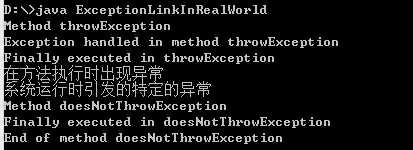标签:
TestInstanceof验证:
public class TestInstanceof
{
public static void main(String[] args)
{
//声明hello时使用Object类,则hello的编译类型是Object,Object是所有类的父类
//但hello变量的实际类型是String
Object hello = "Hello";
//String是Object类的子类,所以返回true。
System.out.println("字符串是否是Object类的实例:" + (hello instanceof Object));
//返回true。
System.out.println("字符串是否是String类的实例:" + (hello instanceof String));
//返回false。
System.out.println("字符串是否是Math类的实例:" + (hello instanceof Math));
//String实现了Comparable接口,所以返回true。
System.out.println("字符串是否是Comparable接口的实例:" + (hello instanceof Comparable));
String a = "Hello";
//String类既不是Math类,也不是Math类的父类,所以下面代码编译无法通过
//System.out.println("字符串是否是Math类的实例:" + (a instanceof Math));
}
}

TestCast的验证:
class Mammal{}
class Dog extends Mammal {}
class Cat extends Mammal{}
public class TestCast
{
public static void main(String args[])
{
Mammal m;
Dog d=new Dog();
Cat c=new Cat();
m=d;
d=m;
d=(Dog)m;
d=c;
c=(Cat)m;
}
}

多态的最基本的特征就是父类变量可以引用子类变量对象。Parent p=new child();
总是可以让更一般的对象容纳更具体化的对象。子类对象可以直接赋值给基类对象。基类对象要赋值给子类对象,必须执行类型转换。语法结构是:子类对象变量=(子类名)基类对象名;也不能乱转换,如果类型转换失败java会抛出以下这种异常:ClassCastException。
public class ParentChildTest {
public static void main(String[] args) {
Parent parent=new Parent();
parent.printValue();
Child child=new Child();
child.printValue();
parent=child;
parent.printValue();
parent.myValue++;
parent.printValue();
((Child)parent).myValue++;
parent.printValue();
}
}
class Parent{
public int myValue=100;
public void printValue() {
System.out.println("Parent.printValue(),myValue="+myValue);
}
}
class Child extends Parent{
public int myValue=200;
public void printValue() {
System.out.println("Child.printValue(),myValue="+myValue);
}
}
子类和父类拥有一样的方法,并且让父类引用子类对象时,调用哪个方法是由对象自己的真实类型决定的,对象是子类型的就调用子类的方法,是父类的,就调用父类的方法。子类有与父类相同的字段,子类中的字段会代替或隐藏父类中的字段,子类方法访问的是子类的字段,如果子类想访问父类被隐藏的字段可以用super调用。如果子类被当做父类使用时,则子类访问的字段是父类的。

异常处理
import javax.swing.*;
class AboutException {
public static void main(String[] a)
{
int i=1, j=0, k;
k=i/j;
try
{
k = i/j; // Causes division-by-zero exception
//throw new Exception("Hello.Exception!");
}
catch ( ArithmeticException e)
{
System.out.println("被0除. "+ e.getMessage());
}
catch (Exception e)
{
if (e instanceof ArithmeticException)
System.out.println("被0除");
else
{
System.out.println(e.getMessage());
}
}
finally
{
JOptionPane.showConfirmDialog(null,"OK");
}
}
}

public class CatchWho {
public static void main(String[] args) {
try {
try {
throw new ArrayIndexOutOfBoundsException();
}
catch(ArrayIndexOutOfBoundsException e) {
System.out.println( "ArrayIndexOutOfBoundsException" + "/内层try-catch");
}
throw new ArithmeticException();
}
catch(ArithmeticException e) {
System.out.println("发生ArithmeticException");
}
catch(ArrayIndexOutOfBoundsException e) {
System.out.println( "ArrayIndexOutOfBoundsException" + "/外层try-catch");
}
}
}

public class CatchWho2 {
public static void main(String[] args) {
try {
try {
throw new ArrayIndexOutOfBoundsException();
}
catch(ArithmeticException e) {
System.out.println( "ArrayIndexOutOfBoundsException" + "/内层try-catch");
}
throw new ArithmeticException();
}
catch(ArithmeticException e) {
System.out.println("发生ArithmeticException");
}
catch(ArrayIndexOutOfBoundsException e) {
System.out.println( "ArrayIndexOutOfBoundsException" + "/外层try-catch");
}
}
}

public class EmbededFinally {
public static void main(String args[]) {
int result;
try {
System.out.println("in Level 1");
try {
System.out.println("in Level 2");
// result=100/0; //Level 2
try {
System.out.println("in Level 3");
result=100/0; //Level 3
}
catch (Exception e) {
System.out.println("Level 3:" + e.getClass().toString());
}
finally {
System.out.println("In Level 3 finally");
}
// result=100/0; //Level 2
}
catch (Exception e) {
System.out.println("Level 2:" + e.getClass().toString());
}
finally {
System.out.println("In Level 2 finally");
}
// result = 100 / 0; //level 1
}
catch (Exception e) {
System.out.println("Level 1:" + e.getClass().toString());
}
finally {
. System.out.println("In Level 1 finally");
}
}
}

public class SystemExitAndFinally {
public static void main(String[] args)
{
try{
System.out.println("in main");
throw new Exception("Exception is thrown in main");
//System.exit(0);
}
catch(Exception e)
{
System.out.println(e.getMessage());
System.exit(0);
}
finally
{
System.out.println("in finally");
}
}
}

// UsingExceptions.java
// Demonstrating the getMessage and printStackTrace
// methods inherited into all exception classes.
public class PrintExceptionStack {
public static void main( String args[] )
{
try {
method1();
}
catch ( Exception e ) {
System.err.println( e.getMessage() + "\n" );
e.printStackTrace();
}
}
public static void method1() throws Exception
{
method2();
}
public static void method2() throws Exception
{
method3();
}
public static void method3() throws Exception
{
throw new Exception( "Exception thrown in method3" );
}
}

import java.io.*;
public class ThrowMultiExceptionsDemo {
public static void main(String[] args)
{
try {
throwsTest();
}
catch(IOException e) {
System.out.println("捕捉异常");
}
}
private static void throwsTest() throws ArithmeticException,IOException {
System.out.println("这只是一个测试");
// 程序处理过程假设发生异常
throw new IOException();
//throw new ArithmeticException();
}
}

import java.io.*;
public class OverrideThrows
{
public void test()throws IOException
{
FileInputStream fis = new FileInputStream("a.txt");
}
}
class Sub extends OverrideThrows
{
//如果test方法声明抛出了比父类方法更大的异常,比如Exception
//则代码将无法编译……
public void test() throws FileNotFoundException
{
//...
}
}
/**
* 自定义的异常类
* @author JinXuLiang
*
*/
class MyException extends Exception
{
public MyException(String Message) {
super(Message);
}
public MyException(String message, Throwable cause) {
super(message, cause);
}
public MyException( Throwable cause) {
super(cause);
}
}
public class ExceptionLinkInRealWorld {
public static void main( String args[] )
{
try {
throwExceptionMethod(); //有可能抛出异常的方法调用
}
catch ( MyException e )
{
System.err.println( e.getMessage() );
System.err.println(e.getCause().getMessage());
}
catch ( Exception e )
{
System.err.println( "Exception handled in main" );
}
doesNotThrowException(); //不抛出异常的方法调用
}
public static void throwExceptionMethod() throws MyException
{
try {
System.out.println( "Method throwException" );
throw new Exception("系统运行时引发的特定的异常"); // 产生了一个特定的异常
}
catch( Exception e )
{
System.err.println(
"Exception handled in method throwException" );
//转换为一个自定义异常,再抛出
throw new MyException("在方法执行时出现异常",e);
}
finally {
System.err.println(
"Finally executed in throwException" );
}

// any code here would not be reached
}
public static void doesNotThrowException()
{
try {
System.out.println( "Method doesNotThrowException" );
}
catch( Exception e )
{
System.err.println( e.toString() );
}
finally {
System.err.println(
"Finally executed in doesNotThrowException" );
}
System.out.println(
"End of method doesNotThrowException" );
}
}

标签:
原文地址:http://www.cnblogs.com/11-05/p/4967460.html